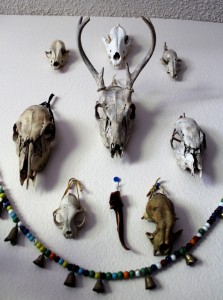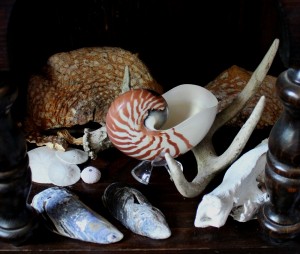In my previous two posts, I discussed a place altar as an introduction to the Altar of Curiosities, and then went into more detail as to what makes it distinct from other cabinets or altars. Today I’m going to walk you through the basics of how to create and work with an Altar of Curiosities of your own.
Curating Along a Theme
The Altar of Curiosities is created with intent, both to be a part of one’s spirituality, and to bring attention to the components themselves. However, you can get more specific than that when it comes to creating a theme for your altar. Here are some ideas to start with:
–Many altars are created to honor a particular deity, the ancestors, or other such beings. An Altar of Curiosities to Artemis of Ephesus, for example, might center on a high-quality replica of the iconic statue, surrounded by other items representing the time period in Greek history when her temple was active, and perhaps some biological specimens from animals that were sacred to her. These would all be chosen not just for their symbolic quality, but their beauty and authenticity as well.
–My own altars are largely place and experience based, built up around locations and their denizens that I’ve created a particularly strong connection with. Not all of the pieces on these altars are museum-quality; often they may be damaged or otherwise imperfect. But they are displayed in such a way as to invite viewers to examine them, and to be good representative items when I tell stories of my adventures in these places and why they are particularly sacred to me.
 –Sometimes a collection develops a spirit of its own. One of my earliest collections was a set of animal skulls that I got from a variety of sources–some found, some gifted, some bought. They traveled around with me as I moved from place to place, and were always configured together. Eventually they became sort of a set of guardians in my home, and I began to work with them as such. The wall I hung them on was considered a vertical altar, often situated above my primary “regular” altar.
–Sometimes a collection develops a spirit of its own. One of my earliest collections was a set of animal skulls that I got from a variety of sources–some found, some gifted, some bought. They traveled around with me as I moved from place to place, and were always configured together. Eventually they became sort of a set of guardians in my home, and I began to work with them as such. The wall I hung them on was considered a vertical altar, often situated above my primary “regular” altar.
Obtaining the Items
You may already have a collection of items or a spiritual altar that you want to nudge into place as an Altar of Curiosities proper. If not, or if you want to add to what you already have, here are a few tips on acquiring new pieces:
–What is it and why do you want it? You might just be a Wiccan who wants a really exemplary set of the classic ritual tools of your tradition, and perhaps a few other pieces that represent your beliefs, which can all be kept to a fairly compact area. However, an Altar of Curiosities can also get out of hand pretty quickly, especially if you don’t have a lot of space to work with. Many people with curiosity cabinets seek completion–all the legal skulls of a given genus of mammal, or water from every sea and ocean around the world, for example. These collections can be turned into a celebration of life, of the waters that sustain the world, of a given culture, etc. On the other hand, don’t feel that you have to have every single representation of a given theme. An Altar of Curiosities centered on the totem Gray Wolf does not need to have one of every wolf statue, book, painting or t-shirt ever created! So before you add something to your altar, ask yourself what its purpose is. This will help you avoid unnecessary clutter.
–Where are you getting it and is it legal to have? The joys of the internet mean that almost anything can be bought online if you look hard enough, and it’s relatively easy (if you have money) to feather your nest with antiquities, fine art, and natural history specimens old and new. But try hitting up local shops, too, both new and secondhand; I’ve found some of my favorite ritual tools at thrift stores. You can, of course, go scrounging about yourself for things like stones, feathers, and even some old human-made relics like broken pottery and the like; however, you’ll want to familiarize yourself with any laws surrounding your actions, both with regards to private and public lands. This is not always a simple task; I’ve spent years working with animal parts in my art and spirituality, and even after almost two decades I am hardly an expert on the relevant laws governing their possession and trade. Fortunately, I’ve found a good roster of dealers and other sources I can work with who I feel assured are selling me legally obtained specimens, but it took a long time to weed out the sketchy ones and to know what to look for. Be aware of your sourcing no matter what you’re getting, and when in doubt contact the relevant government agency before you acquire the piece.
–If you can’t have the original, will a reasonable facsimile serve your needs? There are replicas of all sorts of things out there, from medieval longswords to the bones of extinct creatures. I’ve found that for spiritual purposes a close clone obtained with good intent works pretty well, and the deities/totems/etc. are pretty understanding of the reasons for the substitution. Again, going for good quality pays off here–not only does it show more honor to the spirits/etc., but it improves the aesthetic presentation of the altar. Sometimes you may need to create your own substitute; there are several places on public lands that I’ve connected to, but since there are prohibitions against taking items from these places, I’ve had to create a workaround. I’ll take an item that resembles something from the place–a stone or a leaf or other such thing–and while I’m at the place I’ll either dip it into the nearest source of natural water, or hold it up to the breeze, or otherwise bring it into physical contact with the place. Then I’ll ask the place to put a bit of its energy into this item, and take it home to my altar.
–How do you maintain it once you have it? Some things, like rocks, are pretty self-sustaining in the controlled climate of a home. However, if your altar is centered on a collection of carnivorous plants, you probably already know that they need a lot of care and attention. Familiarize yourself with whatever care your collection needs, whether that’s a polishing kit for metal pieces, necessary nutrition and other care for living beings, and so forth, before you get them.
–What if you’re on a budget? That’s okay! I’m not exactly rich myself, but I manage alright. Accept there are some things you may just not be able to have, at least not right now. You can check with some businesses and sellers to see if they have a layaway plan for larger, more expensive items that you can’t pay for all at once. And you never know what might show up at a secondhand store or estate sale! Even if you don’t have the finest, rarest collection in your Altar of Curiosities, giving it the care and attention it deserves is what’s more important.
It’s Complete–Now What?
Both spiritual altars and cabinets of curiosity were designed to be functional. The former is a place of worship and meditation and offerings; the latter allows a person to display items and educate others about them. You can incorporate both of these purposes into your Altar of Curiosities, and blend them to whatever degree you see fit.
 It’s perfectly fine if all you do with your altar is let it be mostly display, and then have a particular place to leave offerings. I have one particular Altar of Curiosities that’s mostly a display of natural history items, but a chambered nautilus shell also doubles as an offering bowl. However, your altar may be more, well, altar-focused, with beautiful items that also serve very specific purposes in your spirituality. In that case there are a few more things to consider.
It’s perfectly fine if all you do with your altar is let it be mostly display, and then have a particular place to leave offerings. I have one particular Altar of Curiosities that’s mostly a display of natural history items, but a chambered nautilus shell also doubles as an offering bowl. However, your altar may be more, well, altar-focused, with beautiful items that also serve very specific purposes in your spirituality. In that case there are a few more things to consider.
One area where you’ll need to set your boundaries pretty firmly, particularly with regards to other people, is how much others are allowed to handle the items within your altar. A lot of pagans really dislike having other people pick up and look at their ritual tools, even if they ask first. Sometimes they feel that the other person’s “energy” may rub off on the tool; other times they just don’t want to deal with people pawing through their stuff with exclamations of “Ooooh, shiny! What’s this?” All of this is understandable. On the other hand, you may choose to curate a collection that is more handling-friendly, inviting the viewer’s curiosity. Just make sure that anything fragile or potentially hazardous is duly protected.
Another consideration is how permanent you want this particular configuration to be. Are you moving around the various components of your altar with each holiday, season, or other special occasion? Then you may want to be mindful of how portable a given piece is before you bring it home–or you may wish to make larger or more delicate pieces the permanent centerpiece around which everything else is arranged.
How physically active is your practice? If you primarily work with sitting meditation and don’t do a lot of moving around in your rites, then you don’t have to worry about breaking expensive items. On the other hand, if you’re a fan of ritual dance with swords, you may wish to arrange your altar in such a way as to not accidentally skewer something important (to include accidentally falling on your own blades). It may seem to be common-sense, but do a slow-motion practice run of any ritual acts before you actually start the ritual, just to make sure you have the space. Also make sure that any ritual implements you’ll be picking up and setting down are easily accessible without damaging the rest of your altar.
This and the previous two posts may be considered an introduction to the concept of the Altar of Curiosities. If you have any questions on this or related topics, please feel free to ask.
Additionally, I am the organizer of Curious Gallery, a two-day arts festival celebrating cabinets of curiosity and their contents in Portland, OR; you can peruse the official website for what we offered in 2014, and updates and other news as we gear up for our 2015 event this January!
















